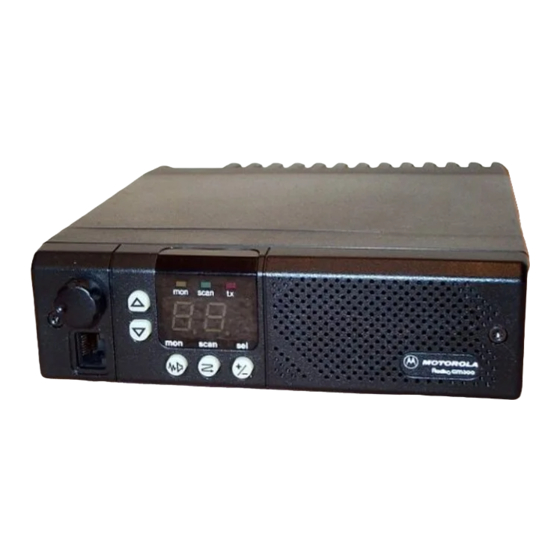Motorola RADIUS GM300 Service Manual - Page 36
Browse online or download pdf Service Manual for Radio Motorola RADIUS GM300. Motorola RADIUS GM300 49 pages. 16-channel, conventional fm radio
Also for Motorola RADIUS GM300: Service Manual (28 pages), Operating Instructions Manual (18 pages), Operating Instructions Manual (19 pages), User Manual (37 pages), Operating Instructions (2 pages)

Name of Manual
impedance of CR2251 appears as a high impedance at
the junction of CR2250 and the harmonic Þlter input.
The harmonic Þlter is a nine pole 0.1 dB ripple Cheby-
chev low pass Þlter with a 3 dB frequency of approxi-
mately 205 MHz and less than 1 dB insertion loss in the
passband.
10-25 Watt VHF Power Amplifier
The 10-25 watt VHF power ampliÞer is designed to
cover the range of 146-174 MHz. It consists of three
stages. The Þrst stage, Q2310, operates in Class A with
base bias supplied by the 9.6T source. The collector
voltage is supplied from controlled B+. The output
level of this stage is varied by changes in the controlled
B+ voltage.
The second stage, Q2320, is operated in Class C. Collec-
tor voltage is supplied by UNSW B+. This stage deliv-
ers up to 3 watts output.
The third stage, Q2330, is the Class C RF Þnal power
ampliÞer. It can output in excess of 30 watts with
3 watts input power. Collector current is monitored by
the power control circuit by measuring the voltage
drop across a .05 ohm resistor, R2371, placed in series
with the collector DC supply lead.
The antenna switch consists of two pin diodes, CR2350
and CR2351. L2353 is parallel-resonant with the off
capacitance of CR2350, increasing its isolation when
turned off. C2354 is a DC block. L2352 and C2352, com-
bined with the ÒonÓ inductance of CR2351, form a
series resonant circuit to lower the shunt impedance
presented by CR2351 when it is turned on.
In the receive mode, both diodes are off. Signals
applied at the antenna jack J1 are routed, via the har-
monic Þlter, through network L2351, C2351 and C2353
to the receiver input. In the transmit mode, 9.6T is
present and both diodes are forward-biased into con-
duction. The transmitter RF from Q2330 is routed
through CR2350, and via the harmonic Þlter to the
antenna jack. CR2351 conducts, shunting RF power
and preventing it from reaching the receiver. L2351 is
selected to appear as a 1/4 wave at VHF, so that the low
impedance of CR2351 appears as a high impedance at
the junction of CR2350 and the harmonic Þlter input.
The harmonic Þlter is a nine pole 0.1 dB ripple Cheby-
chev low pass Þlter with a 3 dB frequency of approxi-
mately 205 MHz and less than 1 dB insertion loss in the
passband.
25-45 Watt VHF Power Amplifier
The 25-45 watt VHF power ampliÞer is designed to
cover the range of 146-174 MHz. It consists of four
stages. The Þrst stage, Q2410, operates in Class A with
its operating voltage supplied by the 9.6T source. It
March, 1997
provides 11 dB of gain and has an output power of
250 mW.
The second stage, Q2320, is operated in Class C. The
collector voltage is supplied from controlled B+. The
output level of this stage is varied by changes in the
controlled B+ voltage. It has a gain of 9.1 dB and pro-
vides up to 2 watts of output power.
The third stage, Q2430, also operates in Class C. The
collector voltage is supplied directly from the UNSW
B+ source. This stage has a gain of 8.8 dB and an output
power of 15 watts. Feedback is used to control the gain
and maintain stability.
The fourth stage, Q2440, is the Class C RF Þnal power
ampliÞer. It has a gain of 6 dB and can output in excess
of 60 watts with 15 watts of input power. The power
control circuit monitors this stageÕs collector current by
measuring the voltage drop across a .01 ohm resistor,
R2471, placed in series with the collector DC supply
lead.
The antenna switch consists of two pin diodes, CR2450
and CR2451. L2453 and C2453, combined with the
internal ÒonÓ inductance of CR2451, form a series reso-
nant circuit to lower the shunt impedance presented by
CR2451 when it is conducting.
In the receive mode, both diodes are off. Signals
applied at the antenna jack J1 are routed, via the har-
monic Þlter, through network L2452, C2454 and C2455
to the receiver input. In the transmit mode, 9.6T is
present and both diodes are forward-biased into con-
duction. The transmitter RF from Q2440 is routed
through CR2450, and via the harmonic Þlter to the
antenna jack. CR2451 conducts, shunting RF power
and preventing it from reaching the receiver. L2452 is
selected to appear as a 1/4 wave at VHF, so that the low
impedance of CR2451 appears as a high impedance at
the junction of CR2450 and the harmonic Þlter input.
The harmonic Þlter is a seven pole 0.1 dB ripple Cheby-
chev low pass Þlter with a 3 dB frequency of approxi-
mately 200 MHz and a typical insertion loss of 0.8 dB
in the passband.
1-10 Watt UHF Power Amplifier
The 1-10 watt UHF power ampliÞer is designed to
cover the range of 438-470 MHz and has three stages.
The Þrst stage, Q2510, operates in Class A. Its operat-
ing voltage is supplied from 9.6T. This stage provides
9 dB of gain and an output of 200 milliwatts.
The second stage, Q2520, has a nominal gain of 10 dB
and power output of up to 2 watts. The output of this
stage is adjusted by varying the controlled B+ which
supplies DC operating voltage to its collector. This
stage operates in Class C.
68 No.
Theory of Operation
RF Power Amplifiers
2-11
